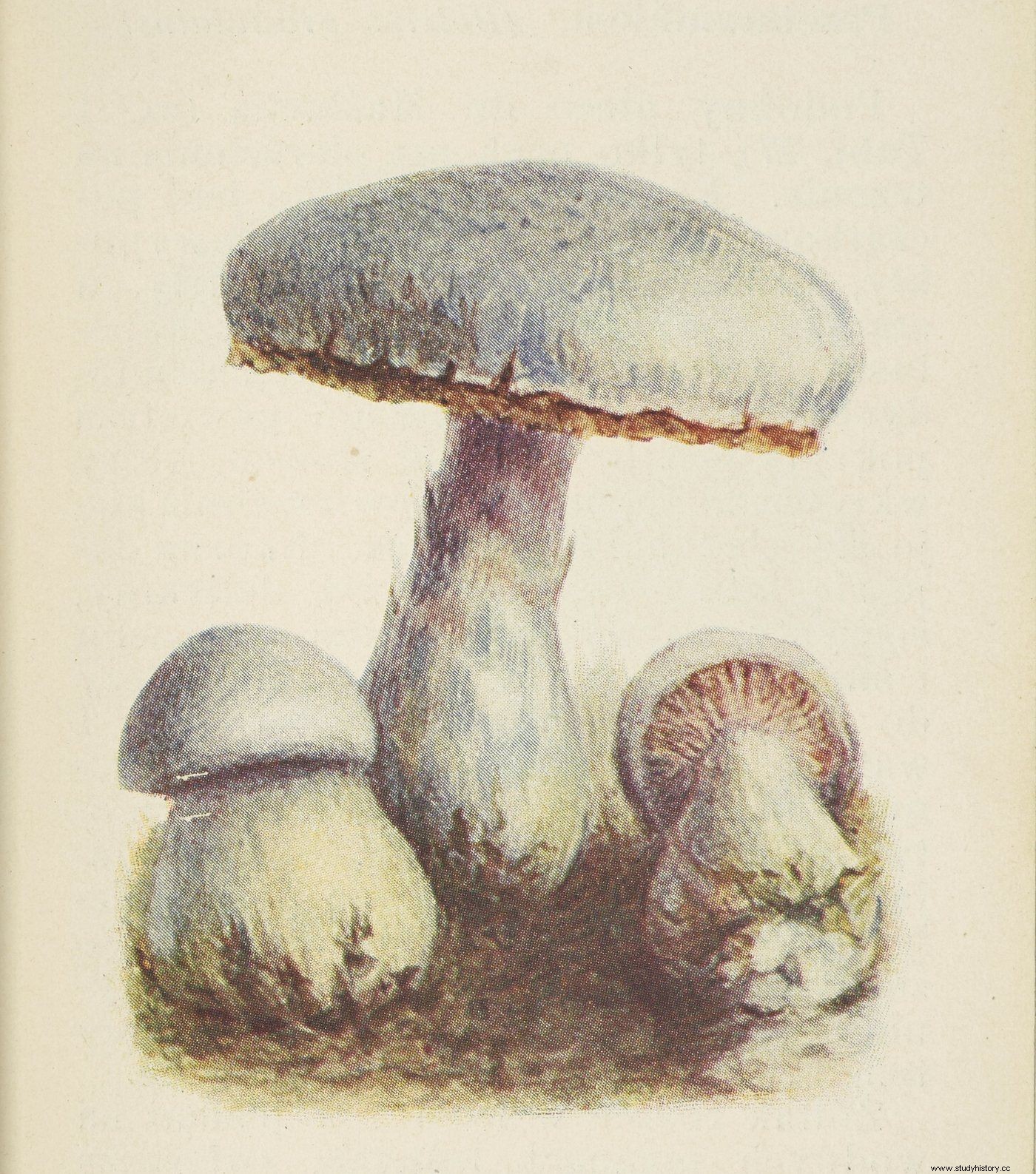We know that its members used to kill in antiquity. They were known even earlier. To this day, some of them eliminate as much as 95% of their victims. Are they at the root of urban legends that someone was deprived of healthy internal organs? Ila really have victims on their conscience?
Usually they act deceitfully, choosing their victims unaware of the danger of people. Their hallmark is a gloomy hat. Underneath it, there are layers of poisonous substances such as amanitin, orelanin and phallotoxin. They often kill slowly:it takes weeks or even years! When someone is lucky, they experience coma, drooling or a damaged liver. The unlucky are doomed to die. Who are we talking about? This murderous gang hiding in the forests of the whole world are… poisonous mushrooms.
Ancient Black Widow and Other Old Cases
Many people believe that the Buddha himself died from mushroom poisoning. Apparently, he was invited by the blacksmith Czunda to a supper consisting of stew of these forest delicacies. He wanted to be polite to the host and did not refuse. Unfortunately, it was the last meal of the Hindu sage. The next day he developed severe diarrhea and died as a result. Earlier, he forgave anyone who gave him a toxic dish by mistake.
An even worse fate befell the Roman emperor Claudius. For this one was deliberately poisoned by her own wife. For this purpose, she probably used the phalloids toadstools. Agrippina did this in AD 54. Why? She wanted her son from her first marriage, Nero, to sit on the throne.

Agrippina was to poison her husband in order to put her son Nero on the throne. The picture shows a portrait of the emperor by Abraham Janssens.
According to some accounts, one-legged murderers have another emperor on their conscience. It is about Charles VI of Habsburg. This ruler, in October 1740, so in high season, went hunting. Then he ate a mushroom stew, after which he immediately felt sick. He returned to Vienna, where he died on October 20. And in what style! The message says that despite the enormous suffering, the monarch found the strength to detest the chamberlain that, as emperor, he was entitled to four candlesticks at the time of his death. Well, the key is to look after your interests to the very end.
The eighteenth-century composer Johann Schobert also fell victim to the "gang", although it may be doubted whether it was a coincidence this time. A man whose music was well known to his contemporaries and inspired by Mozart himself, most probably died at the age of about 32. Six other people fatally poisoned with him.
Details of this tragic event can be found in the correspondence of Baron Grimm. Together with his wife, child and several friends, Schobert went for a walk in the vicinity of Paris. They managed to find some mushrooms. In the evening, the cheerful group went to the tavern, where she asked to prepare a dish from the forest's harvest for them. The chef strongly refused - he immediately noticed that the "gains" were not fit for consumption.
Undaunted, the mushroom pickers made their way to the next inn, where they heard the same. This, however, did not make anyone think, especially since the doctor who participated in the trip assured everyone that there was nothing to be afraid of. Friends decided to prepare the dish at home:they cooked themselves a deadly soup. The effect was predictable. Schobert, along with his wife, children and relatives, including a doctor who was confident in his knowledge, died within a few days. Only the infant who had not yet been weaned survived . It never occurred to anyone to give him a murderous meal…
Poland - the country of mushroom pickers and many victims
Today we know about the members of the one-legged gang a little better. We know, for example, that they should not be given to children under the age of 7 at all. The risk is too great - even every second mushroom poisoned child dies! - and the nutritional value, as most experts say, is low.
However, this has been the case for a short time. Even in 1918, forest treasures were viewed differently. They were considered to diversify the diet and everyone enjoyed being able to taste a good stew with their addition. This was the case at least in one of the schools near Poznań. Just in the year of independence, children were served a dish with mushrooms in the canteen. There was no room for pickiness in those days. What a pity…

The green toadstool (stinkhorn) is what the children from the school near Poznań got poisoned with. Illustration from the mushroom atlas published in 1905.
It turned out that the meal included greenish toadstools. It is a highly poisonous species and even today unlucky gourmets often die after contact with its representatives. They risk damage to the liver and other organs of the body. It is impossible to get rid of the toxins under the hat. Cooking, drying, pickling - nothing will help! Worse still, symptoms only become apparent when it is too late.
There are no details in the accounts of the tragic accident. We can only guess what exactly happened with the group of 31 students. Probably they were suffering from dizziness, nausea, vomiting and bloody diarrhea. They could also have severe circulatory problems. Any improvement, if it had happened, was deceptive. Eventually they all died.
It was not the only case of poisoning from the interwar period that went down in history. In August 1927, Gazeta Polska reported on another, this time family drama. The information was so important that it appeared on the first page! A retired ensign, Stanisław Sobkowiak, who lived in Poznań, gathered a group of hat makers on the way from the church. He thought he was very lucky.

Stanisław Sobkowiak thought he had found mushrooms. It was a miserable mistake.
The wife of the ex-military officer could hardly be convinced that she had mushrooms in front of her. She was suspicious of the fact that the delicacies obtained did not have a characteristic smell or even pinkish gills. However, the father of the family was adamant.
The couple ate a meal prepared with mushrooms at noon, leaving some for their three working children. 23-year-old Leokadia ate little, taking care not to run out of food for her younger brothers - Mieć 16 and Tadzio 20
For the rest of the day, the unfortunate family did well, although their fate was sealed. The sorrows woke the parents at midnight, and the children in the early morning. Then a doctor was called, who, although he did "pump out their stomachs", but did not find it right to hospitalize them. Relatives did their best to nevertheless put the unfortunate five in various hospitals. When they finally succeeded, it was unfortunately too late for most of them. As reported by the press:
Death followed in sequence. Mieczysław died the first, around 11:00, around Tadeusz died on the 22nd at At 23.00, 51-year-old father Stanisław died, and (...) in the morning after On 3, Stanisław S.'s 44-year-old mother died.

A press release from Kurjer Poznański describing the Sobkowiak's funeral.
Only Leokadia survived and ate only 2-3 tablespoons of the unfortunate dish.
The Poznań area seems particularly unhappy when it comes to the activities of forest murderers. Kurjer Poznański of August 31, 1934 reported:“They are multiplying in the last days of mushroom poisoning. The accidents are so serious and so numerous that they could simply be called a terrible epidemic. "
Among other things, the example of a large family from Naramowice is cited. Everyone was poisoned there, except for her mother, who did not eat the treacherous delicacies. 10-year-old Tadeusz, 7-year-old Zenon, 4-year-old Włodzimierz and 3-year-old Aleksandra were hospitalized in a serious condition. Soon their father also joined them.
The tragedies did not pass anyone away
The inattention of eating haters in the case of poorer people is easily explained. The whole family was happy when they managed to collect nice, uneaten-eaten specimens. A varied, aromatic meal was finally getting ready. Unfortunately, mistakes happened quite often. They happen today, albeit on a smaller scale.
It is worth knowing, however, that "one-legged murderers" also killed people who were not "condemned" to mushrooms, but simply wanted them. This was the case with Gustaw Zieliński, a writer and poet who fought in the November Uprising. He became a landowner when he received an inheritance after the death of his uncle. He had an unusually large family:fourteen children out of two marriages! Unfortunately, not all of them lived to adulthood, and this is because of poisonous forest rarities. They killed as many as six young Zieliński!
Fathead's criminal past
It is difficult to name the exact number of victims of the gang of one-legged murderers over the centuries. Even in Poland, where mushroom growing has a long and well-documented tradition, we only have rudimentary data. As Robert Hofrichter, an expert on the subject, writes:"In the Poznań region, then inhabited by 2.2 million inhabitants, 319 people were poisoned with mushrooms in the years 1953–1957, with the mortality rate amounting to 10 percent."
Calculations of this type are not always possible and reliable. All because not every species of poisoners in hats kills at once. For example, rolled-up krowiak turned out to be exceptionally tricky. This mushroom has many names, some of them cute. Cow's mouth, common pig, fat, and regionally ... alder. Sounds more familiar now?

Until recently, it was not realized how dangerous it could be to eat fatty foods. Illustration from the mushroom atlas published in 1905.
We don't know how many people died after eating it, for a simple reason - for years it was considered an edible mushroom. Symptoms of poisoning could take many months or even years to appear. At that time, no one of their relatives knew that the deceased had "eaten olszówka there before the war". Even in the 1970s and 1980s, the fat was described as conditionally edible. And beyond our eastern border, it is still being added to meals!
Toadstool… fly agaric!
It is reassuring that poisonous mushrooms have not always worked to the detriment of humans. Those who knew their lethal properties learned to use them. For example, they used toadstools to poison flies with them. In the villages, in the vicinity of cattle, their plague was particularly troublesome, and there was a lack of effective solutions.
So the mushrooms were soaked in milk. The resulting mixture with a sweetish smell was a perfect lure against insects. After tasting it, the flies fell ... like flies. However, it was only conditional. If no one collected the buzzing intruders at the right moment and threw them out, they could take off after a few days.
Inspiration
The article was inspired by "Biography of a real real" by Pål Karlsen (Horizon Mark 2018).
Bibliography:
- Clyde M. Christensen, Molds, mushrooms and Mycotoxins , University of Minnesota Press 1975.
- Robert Hofrichter, The Mysterious Life of Mushrooms , Prószyński i S-ka 2017.
- Małgorzata Maria Król, Fathers:Wincenty Pol and Gustaw Zieliński , "Scientific Papers of the Catholic University of Lublin" No. 1 (241) / 2018.
- "Kurjer Poznański" 1934.
- "Polska Zbrojna" 1927.
- Nicolas Slonimsky, Slonimsky's Book of Musical Anecdotes , Psychology Press 1948.
